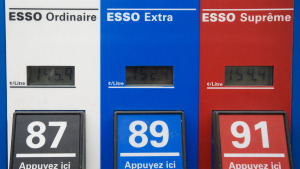Pain at the pumps starts to squeeze economy
 The soaring price of gas is making life difficult for people like Brad Kosid, who drives 550 kilometres a week just to get to work and back.
The soaring price of gas is making life difficult for people like Brad Kosid, who drives 550 kilometres a week just to get to work and back.With money already tight from hefty mortgage payments, the new homeowner from Brantford, Ont., is having to axe much of his entertainment spending from his family budget to pay for the rising cost of fuel.
The 32-year-old says he and his wife, Katie, rarely go out to movies and are cutting back on restaurant meals as they shell out an extra $40 a week for gas, compared to just a few months ago.
“We’re tending to either rent a movie on demand rather than going out and, if she doesn’t feel like cooking, ordering a pizza rather than spend $50 to $60 to go out for a meal,” said Mr. Kosid, who drives a 2009 Hyndai Elantra and travels 55 kilometres each way from Brantford to Burlington, where he works as a sound system installer for an audio store.
“It’s definitely affecting us with those discretionary things. And we’ve noticed that over the last two years that grocery prices are affected by the gas prices and the $100 a week we normally spend doesn’t go as far on groceries.”
Pump prices in Canada have climbed steadily since the beginning of the year, and are approaching record levels set in 2008, when crude prices shot up to $147 (U.S.) a barrel. This week, the Canadian average for regular gas rose to $1.35 per litre, and it topped $1.40 in Toronto, up 20 cents a litre – or 16.7 per cent – since the beginning of the year.
Some analysts expect prices to continue to climb into the summer driving season, perhaps hitting $1.60 or $1.70 a litre if there is a blowup in the Middle East or some unanticipated disruption.
The higher fuel costs are not only painful for motorists. Truckers, airlines and even taxis are being forced to raise their prices, squeezing businesses that find it tough to pass along rising costs to consumers.
Most truckers in Canada now have fuel surcharges built into their rates, and so higher prices immediately get passed on to retailers, grocery stores and other businesses that rely on road transport for their goods.
“Fuel is the No. 1 or No. 2 cost in our operations,” said Steve Lakowski, senior vice-president for the Ontario Truckers Association. “When the fuel price goes up, there’s not an alternative – the fuel surcharge has to be paid.”
But consumers are grumbling and finding ways to economize; it’s a picture they should get used to.
The current price spike this year mirrors the runup last year, when recovering demand and civil war in oil-rich Libya drove the Canadian average price to $1.357 in May, before falling off in the latter half of the year. In fact, the past decade has seen steadily rising oil prices, interrupted only by the great recession of 2008-09.
Bank of Canada Governor Mark Carney is worried that higher pump prices are leaving less money for activities such as travel, or purchases that help spur economic growth.
In overall economic impact, higher prices should be a plus for Canada, which is a net exporter of crude oil. But the benefit is unevenly distributed – primarily affecting oil-producing provinces like Alberta, Saskatchewan, and Newfoundland and Labrador. And the upside has been reduced because Western Canadian producers are facing steep discounts for their crude due to pipeline bottlenecks in the U.S. market.
“As a whole, higher oil prices are a net positive for the Canadian economy,” Mr. Carney said Thursday. “(But) we’re getting at the moment a little less of a positive uplift from higher oil prices than we would normally. And we’re getting that drag on consumption from higher gas prices.”
Consumers now face a perfect storm of ongoing tension in the Middle East, tight supply/demand fundamentals in global crude markets and the restructuring in the refining side of the business – all of which contribute to high pump prices.
As a result, motorists are spending more of their disposable income on gasoline, or finding ways to drive less or save gas. Auto makers, for example, are experiencing strong sales for their smaller, fuel-efficient vehicles.
But in the short term, demand for gasoline is “inelastic” – meaning motorists have a hard time cutting back their consumption despite their intentions to do so, said Pedro Artunes, economist with the Conference Board of Canada, a not-for-profit forecasting group.
In its basket of goods and services that make up the Consumer Price Index, Statistics Canada assumes the average household spends 5.8 per cent of its consumption on gasoline.
“It’s a pretty good chunk of our spending,” Mr. Artunes said. “I don’t think the higher prices will affect our habits when it comes to buying gasoline but it may affect our disposable income when it comes to buying everything else.”
Many motorists are trying to cut back on their mileage.
Keith Threadkell is seeing some of the highest prices in the country – $1.45 a litre – as he commutes from his East Vancouver home to Surrey, B.C., for work. He car-pools with a co-worker and leaves his Volvo S60 in the driveway as much as possible.
“I’m basically now just driving when I have to get groceries or essential services because it’s almost $90 to fill up my tank now,” the 29-year-old engineer said. “And the real concern for me is that I know it’s not just gas prices that are going to go up but everything from food to everything that modern society uses crude supplies for.”
You can return to the main Market News page, or press the Back button on your browser.

